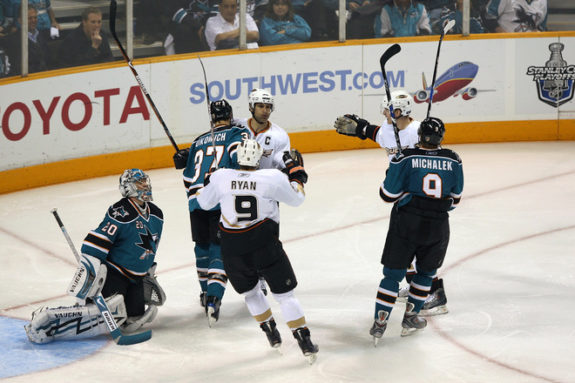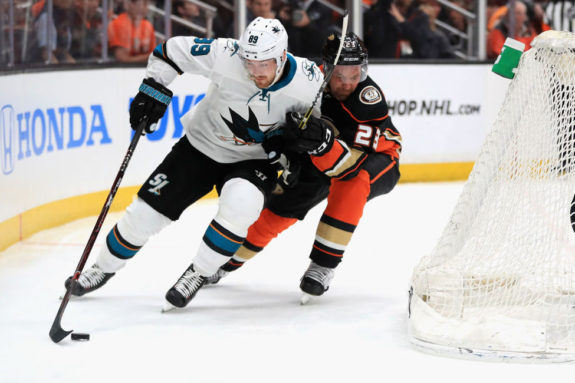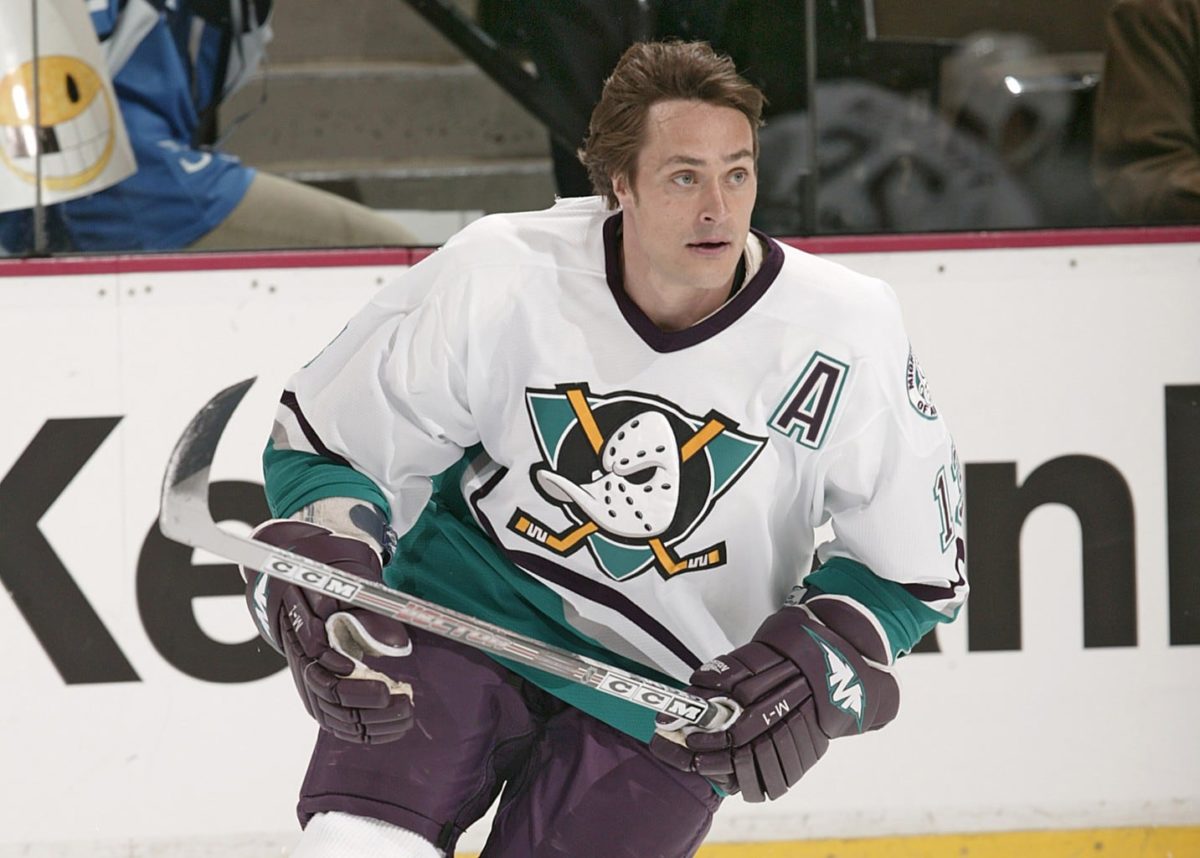On Aug. 9, 1988, the Edmonton Oilers made a trade that changed hockey by sending Wayne Gretzky to the Los Angeles Kings. It’s a trade that is largely regarded as a catalyst for the NHL’s expansion into non-traditional markets, especially in California. Within five years, the NHL added two more California teams – the Anaheim Ducks and the San Jose Sharks. Those three California teams – the Kings, Ducks, and Sharks – naturally developed an intra-state rivalry.

As The Hockey Writers’ former writer Josh Lewis put it, “Making a trade with your biggest rival is like sitting on a public toilet: it’s dirty, it’s gross and you avoid it whenever possible, but on rare occasions, it’s the best option available.”
The Sharks, on occasion, have sat on that toilet.
A Rivalry Birthed in 2008-09
At the end of the 2006-07 season, the Ducks became the first of the three California teams to lift the Stanley Cup. A few seasons later, in the 2009 playoffs, the Sharks and the Ducks met in the postseason for the first time. The Sharks, having won the Presidents’ Trophy as the league’s winningest team in the regular season, were the clear favorites, but the Ducks upset them in six games and ended one of San Jose’s best shots at the Cup so far.

In their next playoff meeting, in 2017-18, the Sharks swept their Southern California rivals in four games before losing to the incipient Vegas Golden Knights in the next round. But despite their painful histories, the teams have agreed upon three trades since entering the league.
Swapping Animal Themed Jerseys
The first trade between the two rivals occurred on March 5, 2001, when the Sharks received the future Hall of Fame forward Teemu Selanne for an experienced Jeff Friesen, a middling goaltender in Steve Shields, and a 2003 second-round pick. That pick became Vojtech Polak, who would play a total of three games in the NHL for the Dallas Stars.
Related: Sharks WIth 100-Point Seasons
It’s safe to say the Sharks were the victors of the trade. Shields played just 33 games for the Ducks before being traded to the Boston Bruins for a third-round pick. Friesen finished the 2000-01 season in Anaheim and played one additional season, where he saw a 20-point statistical drop from his final few years in San Jose. Selanne stayed in San Jose through the 2002-03 season and recorded two 50-plus point seasons, including a team-high 29 goals in 2001-02 and a 64-point campaign in his final campaign in teal. A few years later, he returned to the Ducks where he would eventually win a Cup.

In their next trade, at the 2005 Entry Draft, the Sharks got a 2005 sixth-round pick, which became Tony Lucia and a seventh-round pick in the 2006 Entry Draft, where they took John McCarthy. Lucia never made it higher than the AHL, but McCarthy bounced up and down between the Sharks and their AHL franchise his entire career until his retirement in 2019. Now he coaches for the San Jose Barracuda. They had to give up their 2005 fifth-round pick, which the Ducks used on Brian Salcido, a player who only played two games in the league.
The most recent exchange took place at the trade deadline of the 2008-09 season, the year the Ducks upset the Sharks in the playoffs. Presumably trying to bolster their roster for a playoff run, the Sharks sent the Ducks a young Nick Bonino, a German goaltender in Timo Pielmeier, and a conditional fourth-round pick in exchange for Kent Huskins and Travis Moen.
Huskins and Moen didn’t add much and the Sharks were still ousted in the first round by their trading partners. In losing Bonino, the Sharks got the short end of the stick in this exchange. He had never played a game in a San Jose uniform at the time of the trade and would go on to record 282 points in just under 700 games, a number he is still adding to.
Playoff Drama: Sharks vs Kings
What The Hockey Writers’ former writer Cam Kerry called one of the most underrated rivalries in the NHL, the Sharks and the Kings kicked things into the next gear after meeting in the playoffs for the first time in 2011. The Sharks won the first meeting, but the Kings would go on to win the next two, in the 2013 and 2014 Playoffs.

The 2013-14 playoff series made history, with the Kings becoming just the fourth team in league history to successfully pull off a comeback when down three games to none in a playoff series. They went on to win the Stanley Cup. Their most recent playoff meeting was in 2015-16, the same season the Sharks made their first trip to the Cup Final.
The Lone Trade
All of that to say there is definitely blood in the water between these two teams. So, it may not be surprising that the two teams have only made a single, forgettable trade in their histories.
Related: Top 12 Fastest Skaters Ever in the NHL
On June 21, 2008, at that year’s draft, the Sharks acquired a 2008 fourth-round pick that became Samuel Groulx for a 2009 fourth-round pick (No. 117 – Edward Pasquale) and a 2010 fifth-round pick (No. 148 – Kevin Gravel). The Kings’ pick in the fifth round, Gravel, was the only player involved to become a regular on an NHL roster.
Future Possibilities?
Just a few seasons ago, the Pacific Division made for a difficult road trip for any NHL team, especially the California leg of the trip. The Kings’ core roster has two Cups, the Sharks a Cup Final appearance, and the Ducks were the division champs every year from 2012-13 to 2016-17. This season, though, the best of the three finished 27th in the league. All three missed the playoffs and consecutively finished in the final three spots in the Western Conference.
Latest Sharks Content:
- Sharks’ Thomas Bordeleau Could Be on Outside Looking In
- NHL Rumors: Canadiens, Oilers, Sharks
- San Jose Sharks Giving Ty Emberson a Chance to Impress
- Top Contenders for 2025 Calder Trophy
- Which NHL Playoff Drought Will End This Season?
With the three teams looking to improve things, it’s possible they could view each other as trade partners now more than ever, especially since they aren’t exactly competing for the top seed in the Pacific. But, as of now, there have been no serious rumors of the Sharks trading with either of their intra-state peers.